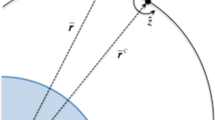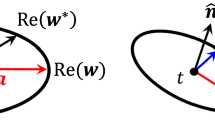Abstract
This paper considers the problem of a deputy spacecraft constrained to remain a fixed distance from another spacecraft. The relative dynamics of the deputy spacecraft are derived from a velocity-dependent potential function. A constant of motion is presented that aids in the development of multiple Lyapunov functions and stabilizing control laws. Through both numerical and analytical methods, estimates of the region of attraction are presented for each of the control laws. These regions of attraction serve as domains on which it is conclusively known that the equilibrium points are stabilizable. Lastly, a control law with a spatially maximal region of attraction is presented that can be used to track a time-varying trajectory.











Similar content being viewed by others
Data availability
All data required to reproduce results of the manuscript are provided in the manuscript.
References
Tatsch, A., Fitz-Coy, N., Gladun, S.: On-orbit servicing: a brief survey. In: Proceedings of the IEEE International Workshop on Safety, Security, and Rescue Robotics (SSRR’06), pp. 276–281 (2006)
Stoll, E., Letschnik, J., Walter, U., Artigas, J., Kremer, P., Preusche, C., Hirzinger, G.: On-orbit servicing. IEEE Robot. Autom. Mag. 16, 29–33 (2009)
Shan, M., Guo, J., Gill, E.: Review and comparison of active space debris capturing and removal methods. Prog. Aerosp. Sci. 80, 18–32 (2016)
Saleh, J.H., Lamassoure, E.S., Hastings, D.E., Newman, D.J.: Flexibility and the value of on-orbit servicing: new customer-centric perspective. J. Spacecr. Rocket. 40(2), 279–291 (2003)
Coll, G.T., Webster, G., Pankiewicz, O., Schlee, K., Aranyos, T., Nufer, B., Fothergill, J., Tamasy, G., Kandula, M., Felt, A., et al.: Satellite servicing projects division restore—l propellant transfer subsystem progress 2020. In: AIAA Propulsion and Energy 2020 Forum, p. 3795 (2020)
Akella, M.: Relative pose estimation using monocular vision for spacecraft proximity operations. In: 2023 American Control Conference, America Automatic Control Council (2023)
Petersen, C., Caverly, R., Phillips, S., Avishai, W.: Safe and constrained rendezvous, proximity operations, and docking. In: 2023 American Control Conference, pp. 3645–3661. America Automatic Control Council (2023)
Kessler, D.J., Johnson, N.L., Liou, J., Matney, M.: The Kessler syndrome: implications to future space operations. Adv. Astronaut. Sci. 137(8), 2010 (2010)
Board, D.M.I.: Overview of the DART mishap investigation results. Tech. Rep., NASA (2006)
Stevens, B.L., Lewis, F.L.: Aircraft Control and Simulation. Wiley (2003)
Shuster, S., Geller, D.K., Harris, M.W.: Analytic impulsive maneuver sequences for nominal safety ellipse reconfigurations. J. Guid. Control Dyn. 43(10), 1837–1853 (2020)
Shuster, S., Geller, D.K., Harris, M.W.: An analytic maneuver sequence for safety ellipse reconfigurations based on relative orbital elements. J. Guid. Control Dyn. 44(9), 1593–1606 (2021)
Woodford, N., Harris, M.W.: Geometric properties of time-optimal controls with state constraints using strong observability. IEEE Trans. Autom. Control 67(12), 6881–6887 (2021)
Woodford, N.T., Harris, M.W.: Spherically constrained relative motion trajectories in low earth orbit. J. Guid. Control Dyn. 46(4), 666–679 (2023)
Harris, M.W., Woodford, N.T.: Equilibria, periodicity, and chaotic behavior in spherically constrained relative orbital motion. Nonlinear Dyn. 111(3), 2723–2739 (2023)
Náprstek, J., Fischer, C.: Limit trajectories in a non-holonomic system of a ball moving inside a spherical cavity. J. Vib. Eng. Technol. 8(2), 269–284 (2020)
Náprstek, J., Fischer, C.: Stable and unstable solutions in auto-parametric resonance zone of a non-holonomic system. Nonlinear Dyn. 99(1), 299–312 (2020)
Desloge, E.: The Gibbs-Appell equations of motion. Am. J. Phys. 56(9), 841–846 (1988)
Udwadia, F.E., Kalaba, R.E.: The explicit Gibbs–Appell equations and generalized inverse forms. Q. Appl. Math. LVI(2), 277–288 (1998)
Náprstek, J., Fischer, C.: Appell–Gibbs approach in dynamics of non-holonomic systems. In: Reyhanoglu, M. (ed.) Nonlinear Systems, ch. 1. IntechOpen, Rijeka (2018)
Náprstek, J., Fischer, C.: Trajectories of a ball moving inside a spherical cavity using first integrals of the governing nonlinear system. Nonlinear Dyn. 106, 1591–1625 (2021)
Clohessy, W., Wiltshire, R.: Terminal guidance system for satellite rendezvous. J. Aerosp. Sci. 27(9), 653–658 (1960)
Khalil, H.: Nonlinear Systems. Prentice Hall (1996)
Sinclair, A.J., Hurtado, J.E.: The motion constants of linear autonomous dynamical systems. Appl. Mech. Rev. 65(4), 040803 (2013)
Rubens Goncalves Salsa, J., Kawano, D.T., Ma, F., Leitmann, G.: The inverse problem of linear Lagrangian dynamics. ASME J. Appl. Mech. 85(3), 031002 (2018)
Greenwood, D.T.: Classical Dynamics. Courier Corporation (1997)
Li, Y., Li, C., He, Z., Shen, Z.: Estimating and enlarging the region of attraction of multi-equilibrium points system by state-dependent edge impulses. Nonlinear Dyn. 103(3), 2421–2436 (2021)
Armiyoon, A.R., Wu, C.Q.: A novel method to identify boundaries of basins of attraction in a dynamical system using Lyapunov exponents and Monte Carlo techniques. Nonlinear Dyn. 79(1), 275–293 (2015)
Curtis, H.: Orbital Mechanics for Engineering Students. Butterworth-Heinemann (2013)
Goldstein, H., Poole, C., Safko, J.: Classical Mechanics. Pearson (2001)
Lewis, F.L., Syrmos, V.L.: Optimal Control, pp. 423–446. John Wiley & Sons Hoboken, NJ, USA (1995)
Funding
The authors declare that no funds, grants, or other support were received during the preparation of this manuscript.
Author information
Authors and Affiliations
Contributions
All authors contributed equally to the technical development of the work. Nathaniel T. Woodford wrote the manuscript and ran the computer simulations. All authors read and approved the final manuscript.
Corresponding author
Ethics declarations
Conflict of interest
The authors have no relevant financial or non-financial interests to disclose.
Additional information
Publisher's Note
Springer Nature remains neutral with regard to jurisdictional claims in published maps and institutional affiliations.
Appendix A
Appendix A
To develop a coordinate system where the singularities are moved to a different set of points, an alternate set of spherical coordinates is introduced. Again, we use the variables \(\rho \in {\mathbb {R}}\), \(\theta \in {\mathbb {R}}\), and \(\phi \in {\mathbb {R}}\) to define the transformation as
The singular points are again at \(\phi = \pm \pi /2\), but these now correspond to the points \((0,\pm R,0)\) in Cartesian coordinates. In accordance with the change of variables, the potential energy function U becomes
The kinetic energy remains
The transformation between control accelerations is given by the equation
Following the procedure outlined in Sect. 3.2, the equations of motion become
We now analyze the equilibrium points \((0,0,\pm R)\) corresponding to \((\theta ,\phi ) = (0,0)\) and \((\pi ,0)\). For a generic equilibrium point \((\theta _e,\phi _e)\), translated spherical coordinates
are introduced so that, in any case, the origin is the equilibrium point in \((\vartheta ,\varphi )\) coordinates. The nonlinear differential equations with zero input are then
1.1 Linear control and numerical RoA
Paper [15] suggests asymptotically stabilizing control law for the \((\theta ,\phi ) = (0,0)\) and \((\pi ,0)\) equilibrium points are
Following the procedure outlined in Sect. 4.2, the results of the numerical RoA estimation are outlined in Table 2.
The results outlined in Table 2 are for values of \(k_d = k_p = 1\). Varying the magnitudes of \(k_d\) and \(k_p\) will change the estimated RoA. The points (0, 0) and \((\pi ,0)\) have the same RoA. Figure 11 depicts the RoA on the zero velocity slice of the domain D, i.e., \(D|_{\dot{\vartheta } = \dot{\varphi } = 0}\).
1.2 Equilibrium points (0, 0) and \((\pi ,0)\)
When \(\theta _e \in \{0,\pi \}\) and \(\phi _e = 0\), the system dynamics are defined as
Given the nonlinear control laws
the closed-loop system becomes
where \(k_d > 0\). For this closed-loop system on the domain D, as defined in Sect. 5, we propose the Lyapunov candidate function
Proposition 11
Given the dynamics described in Eqs. (122a)–(122b) on the domain D, the function V is a Lyapunov function.
Proof
The proof is similar to that of Proposition 5. \(\square \)
Note that V is also continuous on the domain \({\bar{D}}\). The domain \({\bar{D}}\) is defined in Sect. 5.
Proposition 12
On the domain \(\partial {\bar{D}} \subset {\mathbb {R}}^4\) where \(\alpha = \sqrt{3.5}\omega \), the function
has a minimum value of \(\beta = 2\omega ^2\).
Proof
The proof is similar to that of Proposition 6. \(\square \)
Theorem 8
Given the closed loop system defined in (122a)–(122b), a RoA is the set
where \(\gamma \in (0,2\omega ^2)\).
Proof
The proof is similar to that of Theorem 4. As seen in Fig. 12, the ROA of the nonlinear control law encompasses the estimated ROA of the PD control law. \(\square \)
1.3 Analytical RoA for equilibrium points (0, 0) and \((\pi ,0)\)
When \(\theta _e \in \{0,\pi \}\) and \(\phi _e = 0\), the system dynamics are defined as
Given the nonlinear control laws
the closed-loop system becomes
For this closed-loop system on the domain \(D_\pi \), as defined in Sect. 6, we propose the Lyapunov candidate function
Proposition 13
Given the dynamics described in Eqs. (127a)–(127b) on the domain \(D_{\pi }\), the function V is a Lyapunov function.
Proof
The proof is similar to that of Proposition 5. \(\square \)
Note that V is also continuous on the domain \({\bar{D}}_\pi \). The domain \({\bar{D}}_\pi \) is defined in Sect. 6.
Theorem 9
Given the closed loop system defined in (127a)–(127b), a RoA is the set
where \(\gamma \in (0,\omega ^2)\).
Proof
The proof is similar to that of Theorem 4. \(\square \)
Corollary 3
As \(\gamma \rightarrow \omega ^2\), \(\varOmega |_{\dot{\vartheta } = \dot{\varphi } = 0} \rightarrow D_{\pi }|_{\dot{\vartheta } = \dot{\varphi } = 0} \)
Proof
See Corollary 2. \(\square \)
Figure 13 compares the RoA of the three control laws investigated for the equilibrium points (0, 0) and \((\pi ,0)\). As seen in the figure, the RoA for the spatially maximal (SpatMax) control law’s RoA covers the entire sphere at zero velocity except for the equilibrium point \((0,\pi )\) and singular points \((0,\pm \frac{\pi }{2})\).
Rights and permissions
About this article
Cite this article
Woodford, N.T., Harris, M.W. Lyapunov functions and regions of attraction for spherically constrained relative orbital motion. Nonlinear Dyn 112, 3357–3376 (2024). https://doi.org/10.1007/s11071-023-09197-w
Received:
Accepted:
Published:
Issue Date:
DOI: https://doi.org/10.1007/s11071-023-09197-w







